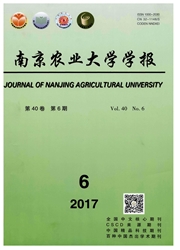

 中文摘要:
中文摘要:
利用含L-色氨酸的基础培养基从仔猪新鲜粪样中分离产吲哚的菌株,根据菌落形态、生理生化特征分析,鉴定该菌株为Escherichia属,命名为wz_1977。通过批次培养的方法,研究了wz_1977以不同碳源为底物时的生长和吲哚生成情况。结果表明:以葡萄糖为底物时,wz_1977的菌落数目显著高于其他各组(P〈0.05),而吲哚生成水平最低;以半乳寡糖为底物时,wz_1977的菌落数目仅次于葡萄糖,而吲哚生成水平高于葡萄糖组;以果寡糖为底物时,wz_1977的菌落数目与对照组(不含碳源)相比没有显著差异(P〉0.05),而吲哚生成水平稍低于对照组(P〈0.05)。结论:分离出1株产吲哚菌wz_1977,该菌的发酵模式为:以葡萄糖为底物时以合成菌体蛋白为主,以果寡糖为底物时以生成吲哚为主。
 英文摘要:
英文摘要:
An indole-producing bacterium named wz_1977 was isolated from fresh faeces of piglets by enrichment in basal medium supplemented with L-tryptophan,and the strain was identified as Escherichia sp.based on its morphology,biochemistry test and 16S rRNA sequencing analysis.We also investigated its characteristics of the growth and indole production with glucose(GLU),galactooligosaccharides(GOS)and fructooligosaccharides(FOS)as substrate respectively.The results indicated that the viable counts did not differ between the control(no carbohydrate)and FOS group,whereas indole concentrations in FOS group were lower than those in control group(P0.05).With GOS as substrate the viable counts of strain wz_1977 were lower and indole levels were higher when compared to GLU group,in which the viable counts were highest with the lowest levels of indole production(P0.05).These results showed that a strain of indole-producing bacterium was isolated from faeces of piglets and in vitro study tryptophan was used for bacterial protein synthesis with GLU as substrate but for indole production with FOS as substrate.
 同期刊论文项目
同期刊论文项目
 同项目期刊论文
同项目期刊论文
 期刊信息
期刊信息
